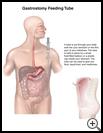
Gastrostomy Care
________________________________________________________________________
KEY POINTS
- A gastrostomy is a surgically created opening in your child’s belly. A tube is placed through the opening in the belly and into the stomach to give your child food and fluids.
- Your medical care team will teach you what you need to know to feel safe and comfortable taking care of the gastrostomy at home.
________________________________________________________________________
What is a gastrostomy?
A gastrostomy is a surgically created opening in your child’s belly. A tube is placed through the opening in the belly and into the stomach to give your child food and fluids. A gastrostomy may be needed if your child cannot swallow or is not able to eat enough food for good nutrition and growth.
A balloon or plastic cap inside the stomach holds the tube in place and prevents leakage. There may be a few inches of the tube sticking out of the opening that can be closed with a clamp or plug, or there may be a button right next to the skin that can be opened to give food and fluids and then closed.
The tube is also called a G-tube or feeding tube.
How do I care for a gastrostomy at home?
Your medical care team will teach you what you need to know to feel safe and comfortable taking care of the gastrostomy at home.
Cleaning and caring for the gastrostomy site
- Wash your hands with soap and water before and after you touch the area.
- Use warm water and soap to clean around the gastrostomy site 2 to 3 times a day or as needed.
- Make sure that you gently soak or scrub off all crusted areas on the skin around the tube and on the tube itself. You may need to use a diluted solution of hydrogen peroxide (1/2 peroxide and 1/2 water) and cotton tipped swabs to clean around the tube site.
- After cleaning, rinse around the area with water and pat dry.
- Ask your healthcare provider if you should use an antibiotic ointment on the area if it looks red or sore.
- Secure the tube as instructed by your healthcare provider.
Bathing
Your healthcare provider will tell you when it is safe for your child to start taking baths or showers again. When your child is able to take a bath or shower, remember to:
- Clamp the G-tube or close the valve on the gastrostomy button before bathing.
- Make sure the water is not too warm, so that it does not irritate tender skin.
- Use only mild soaps and soft washcloths.
Activity
Babies and children with a gastrostomy can do all normal activities such as crawling, walking, jumping, and swimming. Make sure the G-tube is carefully secured under clothing. A G-tube should not keep your child from lying on his or her their stomach. If your child complains that it hurts, you can put a foam ring or soft cloth around the G-tube site to keep pressure off the tube.
Clothes
Overalls, "onesies," or sleepers are helpful for young children who might try to pull out the tube. Older children do not need any special kind of clothing.
School
When your child goes to school, make sure that your child's teacher and school nurse know about your child's gastrostomy. Let them know what to do and who to call in an emergency.
Travel
Your child can travel with a G-tube. Always take a travel kit of emergency supplies with you. The travel kit should include all of the items that you usually need to care for the G-tube. You may also need a replacement tube, supplies, and instructions for replacing the G-tube in case it accidentally comes out.
What problems might my child have with a gastrostomy tube?
Possible problems with a gastrostomy include:
- Blocked tube
Food or medicine may build up in the tube or body fluids may crust around the opening and block the tube. Follow your healthcare provider’s instructions for flushing the tube to clear a blockage. If the tube still seems blocked, call your healthcare provider.
- Drainage around the gastrostomy
Some drainage around the gastrostomy is normal, especially soon after the gastrostomy is put in. Clean the skin around it often with mild soap and water. Make sure you remove all crusted areas from the tube itself. This helps prevent infection. Call your healthcare provider if leaking or drainage continues or if the site becomes painful.
- Vomiting
Vomiting may be caused by the tube moving forward into the stomach and blocking the stomach outlet. Follow your healthcare provider’s instructions for checking the placement of the tube. Excessive gas and overfeeding can cause bloating of the stomach and vomiting. Removing the clamp or the plug or opening the button at the end of the G-tube will allow air to escape and gradually relieve the problem.
- Diarrhea
Diarrhea is a common problem for children with a gastrostomy tube. There are many possible causes of diarrhea, such as the type of liquid food, medicines, changes in the normal bacteria levels in the stomach and intestines, and how fast the liquid food is given. If your child has diarrhea, talk to your healthcare provider about possible causes and treatment.
- Breakdown of the G-tube
Over time, the rubber tube will break down and get harder to use. Many times the end used to add the feeding formula will break off or split. These are signs that the tube needs to be replaced. Most tubes last for 3 to 6 months, if your child needs one for that long.
Last modified: 2018-01-25
Last reviewed: 2018-01-25

